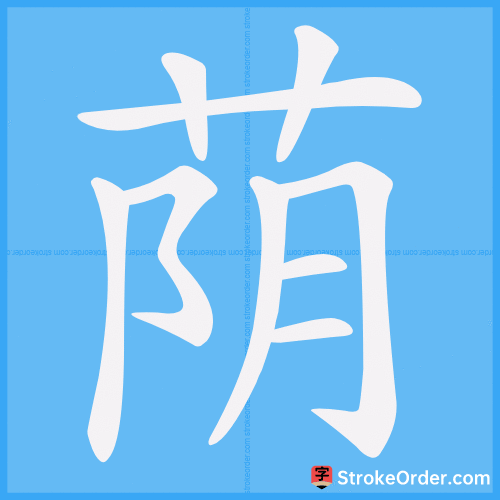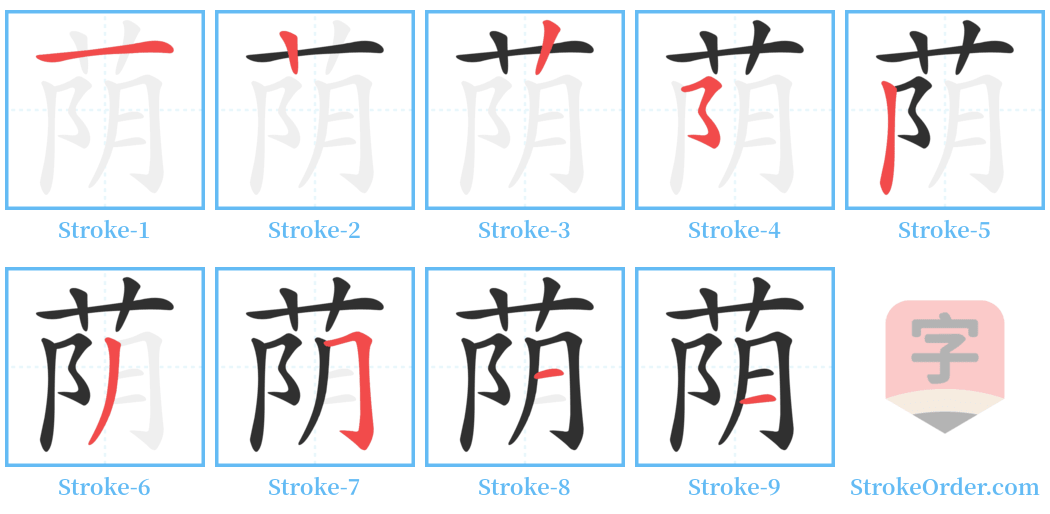荫 Stroke Order
Animated Stroke Order of 荫

Stroke Order Diagrams for 荫

Step-by-Step Handwriting Guide for 荫

Learn to Write Chinese Characters with Video Tutorials
Watch the video of writing the Chinese character "荫", learn the correct stroke order (笔顺) of the character "荫", and master the standard way of writing the character "荫".
Free Printable Handwriting Practice with Stroke Order: 荫
Printable Writing Practice Worksheet of "荫" in Portrait Orientation (Tian Zi Ge)

Printable Writing Practice Worksheet of "荫" in Landscape Orientation (Tian Zi Ge)

Information of 荫
Pinyin
yīn、 yìn
Radical
艹
Strokes
9 strokes
Usage
★★★★★
Definition
shade
荫 (yìn)
1. The shadow created by trees blocking sunlight.
(树木遮住日光所成的阴影。)
2. Shade created by trees.
(树~。)
3. Protection or favor granted. In feudal times, descendants would receive rewards or be exempt from punishment due to the merits of their ancestors.
(庇荫。封建时代子孙因先世有功劳而得到封赏或免罪。)
Meaning breakdown:
- *本义*: Tree shade
- *造字法*: Pictophonetic; composed of the grass radical (艸) and the sound component (阴).
Synonyms:
1. Same as the original meaning
(同本义 [En.] shady)
2. Daylight shadow
(日影 [En.] shade).
3. Refers to a cellar or darkroom
(指地窖或暗室 [En.] cellar; darkroom).
4. To shelter or provide cover
(遮蔽 [En.] shelter).
Feudal-related term:
1. Benefits or privileges conferred upon a descendant by a feudal ruler due to the merit or position of an ancestor.
(庇荫 ([En.] (feudal ruler) conferred privileges on sb.'s descendent).)
Examples:
- The shadow casts by trees offers refuge or a resting place for birds.
(树成荫而众鸟息焉。)
- Use of shade for agricultural benefits or traditional paths.
(荫樊(树荫浓密), 垂荫万亩)
Related texts:
1. In the ancient texts, it mentions the significance of shade in various contexts, establishing the word's usage in literature and historical references.
(《说文》: 荫,草阴也。)
2. Literature examples showing the practical uses of shade and its implications in social status and privilege during the feudal era.
(《西游记》: 继子荫孙图富贵,更无一个肯回头!)
Input Method for 荫
Pinyin
yin1
Wubi
abef
Cangjie
tnlb
Zhengma
eyq
Four Corner
44227
Unicode
U+836b
Same Pronunciation Characters